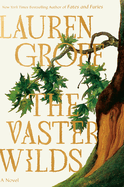
 Lauren Groff's fifth novel, the riveting The Vaster Wilds, combines visceral detail and magisterial sweep as it chronicles a runaway servant's struggle to endure a bitter colonial winter.
Lauren Groff's fifth novel, the riveting The Vaster Wilds, combines visceral detail and magisterial sweep as it chronicles a runaway servant's struggle to endure a bitter colonial winter.
Grounding facts are rare--as in Matrix, Groff's previous work of historical fiction, the outlook perhaps feels more timeless than period-specific--but gradually the scene emerges: the year is 1610 and the teenage protagonist has escaped the famine- and disease-ridden Jamestown colony in Virginia. Not long ago, "the girl," as she is almost always called, sailed from England, accompanying her mistress and the woman's second husband, a minister, and intellectually disabled daughter, Bess. The girl fell in love with a Dutch glassblower while on board ship, but a violent storm separated them.
Flashbacks to these and other traumatic events--living in a poorhouse as an orphan and being taken into service at age four; a gang rape the mistress dismisses as "the daily lot of woman"--seep into her mind as she copes with the harsh reality of life in the wilderness. With faith and resilience, she finds shelter, builds fires, repairs her garments, and subsists on raw fish, duck eggs, and berries. However, terror of the forest and its creatures never leaves. She is right to fear: this is bear country and, though the Powhatan and Piscataway tolerate her presence, men of European descent wish her harm. Groff (Fates and Furies; Arcadia) briefly departs from the close third-person narration to detail masterfully plotted histories of a Jesuit priest turned hermit who deems her a she-devil and a soldier who pursues her, ready to take out his sadism on a "murderess."
The mystery of the incident to which he's referring remains until near the novel's end, adding a filament of suspense to what becomes a classic study of solitude. Groff's loving attention to everyday needs prioritizes the instinct to survive: "I want to live," the girl thinks. "If I stop I will die." Groff notes that "there was still no other way than forward, one step after another toward hope, toward salvation." The style is archaic and postmodern all at once, with outmoded phrasing but nonstandard capitalization and no speech marks. The result is as evocative and affecting as Girl with a Pearl Earring and Year of Wonders--and as brutal as anything Cormac McCarthy has written. The existential threat to women makes it a potent, timely fable as much as a historical novel. --Rebecca Foster, freelance reviewer, proofreader and blogger at Bookish Beck
Shelf Talker: Lauren Groff's fifth novel, set in Virginia in the early 17th century, is a classic study of solitude and survival that stars a teenage girl fleeing starvation--and the scene of a crime.

